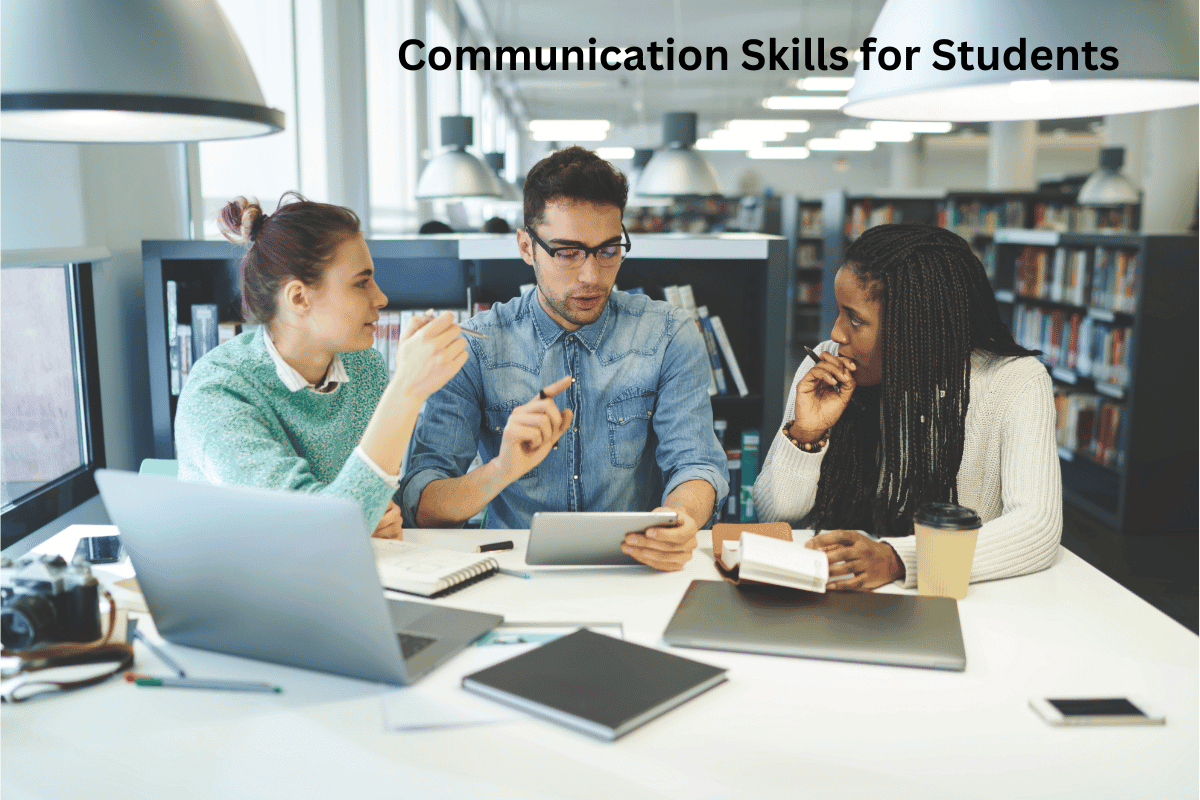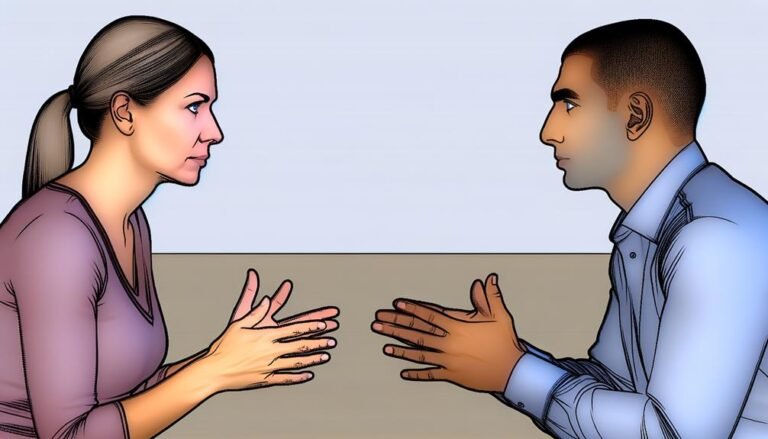Communication Skills for Students
Imagine you’re a student stepping into a time machine, traveling back to a distant era where communication skills were considered a luxury rather than a necessity. As you fast forward to the present day, you find yourself surrounded by a world that thrives on effective communication.
It’s no longer enough to simply exist in a sea of words; you must learn to navigate its depths with finesse and precision. So, why should you bother perfecting your communication skills?
Well, dear reader, the answer lies in the power to influence, connect, and succeed in an increasingly interconnected society.
Key Takeaways
- Communication skills are essential for academic success and future professional endeavors.
- Effective communication involves both verbal and nonverbal techniques.
- Active listening skills play a crucial role in effective communication.
- Understanding and adapting to cultural differences in communication is important.
The Importance of Communication Skills
Communication skills are crucial for students as they play a vital role in their academic success and future professional endeavors. Developing effective communication skills is essential for students to thrive in the workplace and excel in their careers. In today’s fast-paced and interconnected world, the ability to communicate clearly and confidently is highly valued by employers.
One aspect of communication in the workplace that students should focus on is public speaking skills. Public speaking is a valuable skill that allows individuals to present their ideas, influence others, and showcase their expertise. Whether it’s presenting a project in front of a class or giving a presentation to a group of colleagues, strong public speaking skills can make a significant impact.
Verbal Communication Techniques
Now let’s dive into the verbal communication techniques that will help you become a more effective communicator.
One important aspect is being aware of body language cues, such as facial expressions and gestures, as they can convey a lot about your thoughts and feelings.
Additionally, developing active listening skills, where you fully engage with the speaker and demonstrate understanding, is crucial for effective verbal communication.
Body Language Cues
Using nonverbal cues can greatly enhance your verbal communication skills. Body language cues play a crucial role in conveying your message effectively. Here are four nonverbal communication techniques that can help you improve your communication skills:
- Eye contact: Maintain appropriate eye contact with the person you’re speaking to. It shows attentiveness and engagement in the conversation.
- Facial expressions: Use facial expressions to express your emotions and convey your message more clearly. Smiling can create a positive and friendly atmosphere.
- Posture: Stand or sit up straight to demonstrate confidence and attentiveness. Slouching can give the impression of disinterest or lack of confidence.
- Gestures: Use hand gestures to emphasize key points or to express your thoughts. However, be mindful of excessive or distracting gestures that can hinder effective communication.
Active Listening Skills
To improve your communication skills, mastering active listening techniques is essential. Active listening involves more than just hearing what someone is saying. It requires improving focus and actively engaging with the speaker. By practicing active listening, you can strengthen your understanding, build trust, and enhance your overall communication skills.
One way to improve focus and actively engage is by using non-verbal cues such as maintaining eye contact, nodding, and providing verbal affirmations. Additionally, paraphrasing and summarizing what the speaker has said demonstrates your understanding and encourages further conversation. Finally, asking open-ended questions shows your interest and encourages the speaker to share more.
By incorporating these active listening techniques into your communication skills, you can become a more effective listener and communicator. The table below summarizes these techniques:
| Active Listening Techniques | |
|---|---|
| Use non-verbal cues | Maintain eye contact, nod, provide verbal affirmations |
| Paraphrase and summarize | Demonstrate understanding and encourage conversation |
| Ask open-ended questions | Show interest and encourage sharing |
Nonverbal Communication Strategies
Now let’s talk about the importance of nonverbal communication strategies.
Your body language plays a crucial role in communication, as it can convey your emotions, intentions, and level of engagement.
Maintaining effective eye contact is another vital aspect of nonverbal communication, as it shows your attentiveness and interest in the conversation.
Body Language Importance
Nonverbal communication strategies play a crucial role in conveying messages effectively and are essential for students to develop strong communication skills. Body language, consisting of nonverbal signals and cues, can greatly impact how your message is perceived. Here are four reasons why understanding and utilizing body language is important:
- Enhances understanding: Body language can provide additional meaning to your words, helping others better understand your intentions and emotions.
- Builds rapport: Nonverbal cues like eye contact, facial expressions, and gestures can help establish a connection with your audience, fostering trust and rapport.
- Conveys confidence: Good posture and a confident demeanor can make you appear more self-assured and credible.
- Improves listening skills: Paying attention to others’ body language can help you pick up on subtle cues, allowing for better comprehension and active listening.
Effective Eye Contact
Using effective eye contact is a powerful nonverbal communication strategy that can greatly enhance your ability to connect and engage with others.
When you maintain eye contact with someone, it shows that you’re actively listening and interested in what they have to say. It creates a sense of trust and openness, fostering a deeper connection between you and the person you’re communicating with.
Additionally, eye contact helps to improve engagement by signaling that you’re fully present in the conversation. It allows you to pick up on nonverbal cues and emotions, enabling you to respond appropriately.
Active Listening Skills
To develop effective communication skills, you should focus on honing your active listening abilities. Active listening is a crucial skill that allows you to fully understand and engage with others during conversations. Here are four techniques to improve your listening skills:
- Maintain eye contact: When you make eye contact with the speaker, it shows that you’re paying attention and interested in what they’ve to say. It also helps you pick up on non-verbal cues and emotions.
- Avoid interruptions: Interrupting a speaker can be disrespectful and disrupt the flow of conversation. Practice patience and wait for the speaker to finish before responding or asking questions.
- Show empathy: Empathy involves understanding and sharing the feelings of another person. By showing empathy, you demonstrate that you care about the speaker’s perspective and are willing to listen without judgment.
- Practice reflective listening: Reflective listening involves paraphrasing or summarizing what the speaker has said to ensure you have understood their message correctly. It shows that you’re actively engaged and interested in the conversation.
Effective Presentation Skills
Now let’s shift our focus to developing effective presentation skills, a crucial aspect of effective communication for students. When it comes to presentation delivery, there are several public speaking techniques that can help you engage your audience and convey your message effectively.
To assist you in understanding these techniques better, let’s take a look at the following table:
| Public Speaking Technique | Explanation |
|---|---|
| Maintain eye contact | Establishing eye contact with your audience helps build trust and connection. |
| Use clear and concise language | Avoid jargon and speak in a manner that everyone can understand. |
| Utilize visual aids | Incorporating visual aids such as slides or props can enhance audience engagement. |
Building Stronger Relationships Through Communication
Developing strong communication skills can significantly enhance your ability to build and maintain relationships. Effective communication is the foundation for building trust and establishing meaningful connections with others. By honing your communication skills, you can foster stronger relationships in both personal and professional settings.
Here are four key ways in which effective communication can help you build stronger relationships:
- Active listening: When you actively listen to others, you show genuine interest in what they have to say. This promotes understanding, empathy, and mutual respect, which are essential for building trust.
- Clear and concise expression: Being able to articulate your thoughts and ideas clearly and concisely allows others to understand you better. This clarity fosters effective communication and minimizes misunderstandings.
- Non-verbal cues: Pay attention to your body language, facial expressions, and tone of voice. These non-verbal cues can convey sincerity, empathy, and understanding, strengthening your connection with others.
- Conflict resolution: Effective communication skills can also help you navigate conflicts and disagreements. By expressing your concerns respectfully and actively listening to the other person’s perspective, you can find common ground and resolve conflicts amicably.
Enhancing Written Communication Abilities
By honing your communication skills, you can also greatly enhance your written communication abilities, which are vital in various personal and professional contexts.
Improving your grammar is a fundamental aspect of written communication. It involves understanding the rules of sentence structure, punctuation, and word usage. Proper grammar ensures clarity and precision in your writing, making it easier for others to understand your message.
Another important aspect of enhancing written communication abilities is mastering email etiquette. In today’s digital age, email is a common form of written communication, especially in professional settings. Understanding the appropriate tone, formatting, and structure of emails is crucial.
Always start with a professional greeting and use clear and concise language. Avoid using jargon or slang that may confuse the recipient. It’s also important to proofread your emails before sending them to ensure accuracy and professionalism.
Overcoming Communication Barriers
To effectively overcome communication barriers, it’s essential to understand the various obstacles that can hinder effective communication. Here are four key barriers and strategies to overcome them:
- Language barriers: When communicating with someone who speaks a different language, make an effort to learn basic phrases or use translation tools. Use simple and clear language, avoid jargon, and be patient with misunderstandings.
- Cultural communication challenges: Different cultures have unique communication styles and norms. Educate yourself about cultural differences and adapt your communication accordingly. Be mindful of non-verbal cues, such as gestures and body language, which may vary across cultures.
- Lack of active listening: Effective communication involves active listening, where you fully engage with the speaker and understand their perspective. Practice active listening by maintaining eye contact, nodding to show understanding, and asking clarifying questions.
- Emotional barriers: Emotions can hinder communication by clouding our judgment and causing misunderstandings. Manage your emotions by staying calm and composed, expressing yourself assertively rather than aggressively, and being empathetic towards others.
Developing Confidence in Communication
Improving your communication skills is essential for developing confidence in your ability to effectively convey your thoughts and ideas. Building self-esteem and developing strong public speaking skills are crucial aspects of developing confidence in communication.
Building self-esteem is a foundational step in developing confidence. When you have a positive self-image, it becomes easier to express yourself confidently. To build self-esteem, focus on your strengths, set realistic goals, and celebrate your achievements, no matter how small they may seem.
Public speaking skills are also instrumental in developing confidence in communication. Effective public speaking involves techniques like maintaining eye contact, using appropriate body language, and speaking with clarity and conviction. Practicing these skills in a supportive environment, such as joining a public speaking club or taking a public speaking class, can help you gain confidence and overcome any fear or anxiety associated with speaking in front of others.
Conclusion
So there you have it, folks! Communication skills are just another burden you students have to bear.
Who needs clear and effective communication anyway?
It’s not like it’s important in the real world or anything.
So go ahead, disregard these strategies and continue stumbling through life with your mumbled words and awkward gestures.
Good luck!







